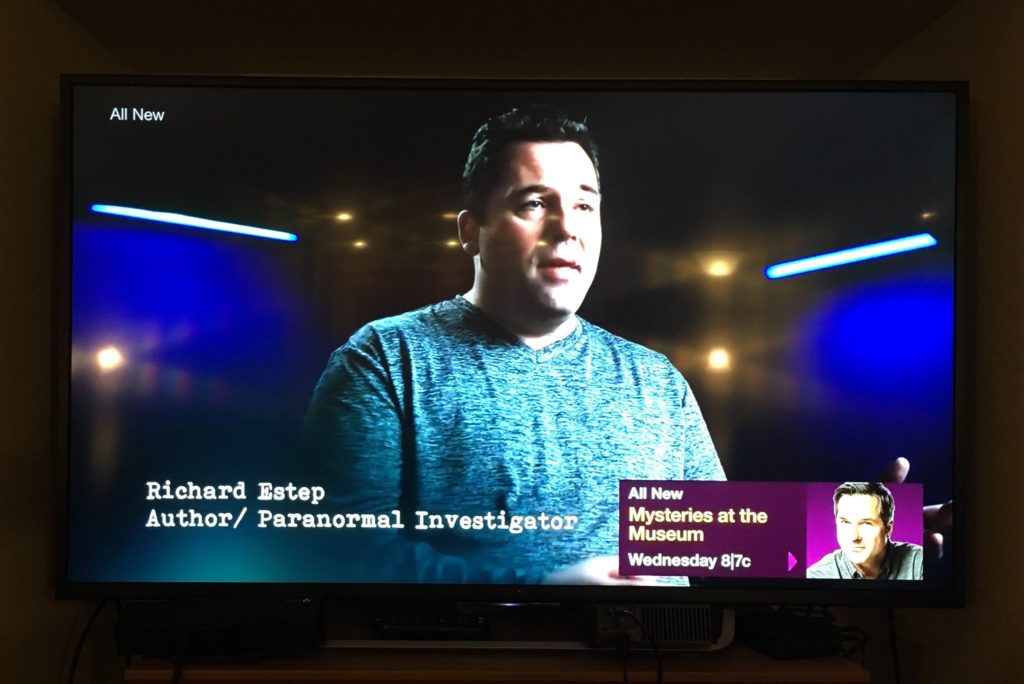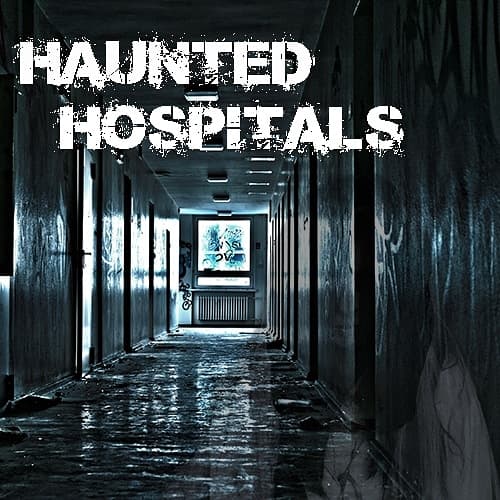
The idea behind this blog entry is to give my thoughts on some of the cases that we cover on Haunted Hospitals.
Please note that these are purely my owns opinions, and do not necessarily reflect (and are not endorsed by) the producers and broadcasters of the show, which has aired on Quest Red in the UK, T&E in Canada, and is currently airing on Travel Channel in the USA. I love the show and very much enjoy working on it. Please watch the episode before reading this blog entry because, well,spoilers…
I’m going to preface what I hope will be the first in a series of blog entries like this by saying that the integrity and willingness to listen that was shown by the production team on Haunted Hospitals genuinely impressed me. Before working on the show, I couldn’t help but wonder if the approach was going to be something along the lines of “Hey, let’s inflate the hell out of these stories, make ‘em as scary as possible, and above all else, let’s not let the facts get in the way of a good story.’
I was delighted to find that I couldn’t have been more wrong. Although many of the stories on the show can be very frightening indeed, and a degree of dramatization is involved (pretty much an essential part of keeping the audience on the edge of their seats) the producer and director were always willing to consider different points of view, and went to great lengths to keep each story as accurate and fairly-represented as possible.
Season 1, episode 1 is titled Dead Man Rotting. I was assigned to be the expert for the first segment, ‘Demonic Invasion.’ The word demonic can be a contentious one, both within and outside of the paranormal interest community. Personally, I try my very best not to use it. In a nutshell, here’s why: for the first fifteen years of my career as a paranormal investigator, I saw very few dark or negative-type hauntings. Then, after a number of TV para-‘reality’ shows exploded onto the scene, suddenly the words ‘demon’ and ‘demonic’ seemed to be everywhere. A book falls off a shelf? Demonic activity. Shadow figure in the hallway? Demon. Etcetera etcetera.
It is fair to say that, since I relocated from the UK to the States in 1999, I have been asked to investigate many more calls that are darker in nature. The reasons for this are up for speculation (and could probably be the subject of an entire blog post) but suffice it so say that I believe the word ‘demon’ carries a great deal of baggage (so does the word ‘orb’). I am open to the possibility of the existence of non-human or inhuman entities — creatures that have never walked this Earth in human form — but I also find it likely that many aggressive hauntings, those which are often blamed on demons or inhuman entities, could actually be the spirits of deceased human beings that are acting aggressively. After all, there are plenty of people walking the streets of your home town who punch, scratch, and kick others at the slightest provocation. Why would we assume that this type of behavior would change once they are dead?
With that being said, some of the more destructive hauntings can indeed be candidates for being inhuman/demonic in nature. We begin in New York, where nursing assistants Garrett and Maria are starting their new jobs on the med/surg floor of a hospital. They spend a lot of time working in the medical records section, which is essentially a dark and claustrophobic room. Maria feels as if she is constantly being watched, and the room is perpetually cold.

I talk about the human body being the most sensitive ghost detector. There are two ways to look at this. On the one hand, it is quite easily fooled. Ever watch a scary movie and feel chills run down your spine, or your heart skip a beat? That’s your body reacting to something scary that you nonetheless know cannot hurt you.
But on the other hand, many paranormal investigators subscribe to the theory that many people can subconsciously sense the presence of spirit entities in the immediate area, and that the body’s autonomic nervous system will begin to react to this unseen presence, treating it as a potential threat. This is the classic ‘fight or flight’ response at work, and may be your body’s way of trying to warn you. The strength of this response can vary from the subtle (a moderately-increased heart rate) to the full-blown pounding heart, sweaty skin, dilated pupils, and shaky-hands reaction.
One aspect of the paranormal that I would love to see studied in more detail (preferably by somebody far more qualified than myself) is the relationship between human physiology and supposedly haunted locations. How exactly do our bodies react when something paranormal is taking place? One attempt to answer this question took place on the vastly under-Grated show Ghost Stalkers. During their Farrar Elementary School episode, investigators John E.L. Tenney and Chad Lindberg were hooked up to medical sensing equipment by David Rountree. This experiment, while far from conclusive, strongly suggested that more research is needed in this area.
Garrett encounters some strange behavior on the part of some electrical equipment — not at all uncommon during many hauntings — while Maria’s sense of foreboding deepens. Then she encounters a floating shadow which, in her own words, “freaked me the hell out.” Hard to blame her, and easy to understand why she didn’t report the experience to her supervisor at the hospital. Nobody wants to be known as ‘the ghost person’ in a hospital. It’s a great way to have your colleagues think that you might be a little too imaginative and perhaps a little unstable.
Yet the truth is that the medical profession attracts more than its fair share of paranormal activity. Melissa and Garrett are in good company. Some of the barriers are starting to come down, and more people are beginning to come forward to share their experiences…sometimes this happens after the eyewitnesses leave the medical field behind, and on occasions it takes the facility itself being closed down and abandoned for the stories to begin circulating. Look at it from the point of view of a hospital administrator: a hospital is supposed to be a place of healing and convalescence. Stories of ghosts walking the halls and frightening patients and staff alike are not exactly conducive to rest and recovery. Far better to suppress them or laugh them off as being nothing more than tall tales — at least, until you encounter one for yourself…
Maria’s haunting now turns violent, with an invisible pair of hands suddenly beginning to choke her. It is her belief that she is under attack by a demonic entity. Fortunately she was able to break free, and after returning home in a distraught emotional state, begins to doubt the reality of the experience — is it possible that her imagination simply made the whole thing up?
And then she finds out that the entity has followed her home.
It’s possible that Maria has gotten herself an attachment — essentially, a negative entity has latched onto her, and is now using every trick in the book in order to cause as much fear as possible. The motivation for doing this is a simple one. Such parasitic entities are believed to feed on negative emotional energy, the stronger the better…which means that it has a vested interest in making Maria and Garrett (her boyfriend, who she lives with) as terrified as possible.
Any possibility that Maria’s mind has been playing tricks on her is dispelled when Garrett sees the dark entity too, right there in their own living room. The terror ratchets up a notch when Garrett begins having nightmares…nightmares in which a dark creatures with glowing eyes is right there in the bedroom. He senses that it is there because of him, and is understandably shaken by the experience.
The young couple fights back by saging the house, which seems to provoke the entity rather than drive it out. What follows is, in Maria’s own words, “a spiritual battle” for control of their home. Although we don’t get many details on the specifics, I usually advise clients to lay down the law when their home has been invaded by some kind of psychic parasite. Set clear boundaries, and let them know in no uncertain terms that they are unwelcome and do not have permission to stay there. Sometimes this works, and the entity leaves. If that doesn’t happen, then it’s often necessary to break out the spiritual heavy artillery — usually in the form of a priest or similar holy person, in order to bless, cleanse, or exorcize the house.
(As an aside, this can also work if the occupants of the home are not religious or followers of a particular faith. As an agnostic, I was pleasantly surprised when the cleansing of my own home by a Catholic priest caused the complete cessation of the paranormal activity that had been bugging my wife and I for several weeks after I had left a particularly haunted location).
In the case of Maria and Garrett, the results were decidedly mixed. Although the entity has left their house, it now returns to the hospital and once more begins to plague them there. Finally deciding that enough is enough, the couple quits and moves out of state, leaving their mysterious oppressor to its own devices…
One is forced to wonder whether other staff at the hospital are experiencing something similar. It may be that Maria was simply the ‘right’ person, psychically speaking, for it to attach to. The relationship between negative spirits and the living people they attach to can be a lot like that between a medication or drug and its receptor. Molecules of a medication can only bind to a very specific type of target receptor on cells. For example, nicotine can only attach and bind to nicotinic receptors within the body, after which a reaction is triggered and the desired physiologic response takes place. If the drug doesn’t match the receptor, nothing happens. In much the same way, unless the target individual is in the correct emotional and psychic state (I suspect there are also physiologic factors at play) then the entity in question will be unable to affect them, and will simply hang around and wait for the next person to come along, in the hopes that they will be more vulnerable.
That’s all for this week, ladies and gentlemen. Thanks for reading, thanks for watching, and thanks for supporting my writing.
— Richard


